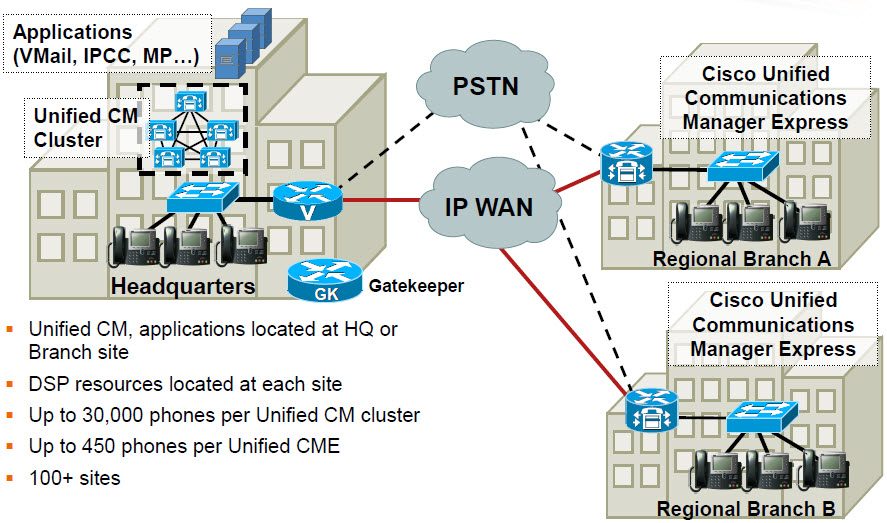|
Cisco Unified Communications (UC) is an IP-based communications system integrating voice, video, data, and mobility products and applications. It enables more effective, secure communications and can transform the way in which we communicate. UC represents a communications paradigm shift like that of the invention of the telegraph. UC removes the geographic barriers of effective communications through the use of voice, video, and data integration. Business can be conducted with a fluidity that progresses and evolves with you. Information has been at our fingertips for a long time, but UC
enables the sharing of this information to create knowledge and value.
Cisco UC is part of an integrated solution that includes network infrastructure, security, mobility, network management products, lifecycle services, flexible deployment, and third-party communication applications.
Cisco UC can impact the bottom line by creating more effective communications without losing the personal nature of a face-to-face conversation. More effective communications lead to reduced time to market and nimble transformation of business processes through collaboration.
1. The components of the standard layers are as follows:
- Infrastructure layer: The infrastructure consists of routers, switches, and voice gateways.
The infrastructure layer carries voice, video, and data between all network devices
and applications. This layer also provides high availability, management, quality
of service (QoS), and network security.
- Call control layer: The call control layer provides call processing, device control,
and administration of the dial plan and features. Call control can be provided by
CUCM, Cisco Unified Communications Manger Express (CUCME), or CUCM
Business Edition (CUCMBE).
- Applications layer: Applications are independent from call-control functions and the
physical voice ports. Application servers are integrated through IP, which allows the
applications to reside anywhere within the network
- Endpoints layer: The endpoints layer brings applications to the user, whether the end
device is a Cisco IP Phone, a PC using a software-based phone, or a communications
client or video terminal. Cisco UC provides multiprotocol support for Skinny Client
Control Protocol (SCCP), H.323, MGCP, and SIP.
2. Deployment Models

- CUCM provides these functions:
■ Call processing: Call processing refers to the complete process of originating, routing,and terminating calls, including any billing and statistical collection processes.
■ Signaling and device control: CUCM terminates and coordinates all signaling events between call endpoints and directs devices such as phones, gateways, and conference bridges to establish and tear down streaming RTP media connections. Signaling is also referred to as call control and call setup/call teardown.
■ Dial plan administration: The dial plan is a set of configurable patterns that CUCM uses to perform call routing. CUCM is responsible for digit analysis (DA) of all calls into or out of the CUCM cluster.
■ Phone feature administration: CUCM extends supplementary services such as hold, transfer, forward, conference, speed dial, redial, and call park to IP phones and gateways.
■ Directory services: CUCM uses a portion of the Informix Database Server (IDS) Lightweight Directory Access Protocol version 3 (LDAPv3) database to store user information. User authentication can be performed locally or against an external directory service. Directory synchronization allows centralized user management. Directory synchronization allows CUCM to leverage users already configured in a corporate-wide directory service, such as Microsoft Active Directory 2003 and2008, Microsoft Active Directory Application Mode (ADAM) 2003, Microsoft Lightweight Directory Services 2008, iPlanet Directory Server 5.1, Sun ONE 5.2 and 6.X, and OpenLDAP 2.3.39 and 2.4 directory integrations. The local CUCM database is an LDAP-compliant database (LDAPv3) component in the IBM Informix Database Server (IDS).
■ Backup and restore tools: CUCM provides a Disaster Recovery System (DRS) to back up and restore the CUCM configuration database. The DRS also backs up call detail records (CDR), call management records (CMR), and the CDR Analysis and the CDR Analysis and Reporting (CAR) database. |
